Harver is a leading provider of pre-employment assessments offering a wide range of online tests designed to help organizations identify the best candidate for their team. It is a technology-driven platform that uses AI to streamline hiring by automating candidate screening, assessment, and selection.
Preparing for a Harver assessment can be a daunting task. But with the right approach and mindset, a candidate can showcase their skills, potential, and capabilities to employers. The platform features numerous assessments that evaluate cognitive abilities, situational judgment, and personality traits.
Did you know?
Several Harver assessments, like cognitive ability tests, are also available on the platform in a gamified version. Many companies use this version for their hiring process to make the assessment more engaging. Although it is similar to the initial version of the test, it is slightly different.
Employers depend on these tests as they take much of the hiring burden off their shoulders. Therefore, the candidates must prepare and thoroughly understand what to expect while taking the test to have the best chances of success. They must practice, take mock exams, and research the assessment they are taking.
Harver Question Types
The Harver assessment you take depends upon the job position you are applying for and your recruiters. So, let’s get an understanding of these assessments:
Cognitive Ability Test
Cognitive ability is considered the best predictor of job success for every employment level throughout the industries. It provides a good understanding of a candidate’s ability to learn, apply the knowledge practically, and solve issues. Cognitive ability assessments increase the quality of hire and improve the company’s bottom line.
Cognitive ability is an umbrella term for several aspects that make up the candidate’s General Mental Ability (GMA). GMA involves problem-solving, reasoning, abstract thinking, planning, complex idea comprehension, and learning from experience. The more complicated a job is, the more effective the cognitive ability assessments are for predicting future on-the-job performance.
The different aspects of a candidate’s cognitive ability help employers get a better understanding of their mental processes.
Assessing cognitive ability with Harver
The most significant limitation of a cognitive ability test is the propensity to demonstrate adverse impact. Harver’s Cognitive Ability Assessment has been constructed by following a robust methodology with a focus on lessening the effects of harmful impact.
General intelligence is an ideal reference for how Harver assesses cognitive ability. Harver’s cognitive ability combines learned knowledge (crystal intelligence), fluid intelligence (practical implementation to novel situations), and accuracy and speed, allowing employers to analyze a person’s cognitive abilities.
Harver’s cognitive ability consists of five components that measure a wide spectrum of cognitive skills.
Components of Cognitive Ability Testing
Logical Reasoning
The Logical Reasoning assessment helps an employer predict the success rate of a candidate’s complex decision-making and problem-solving characteristics. It measures the ability to make visual comparisons, recognize patterns, observe relevant details, and detect abnormalities.
Sample Question
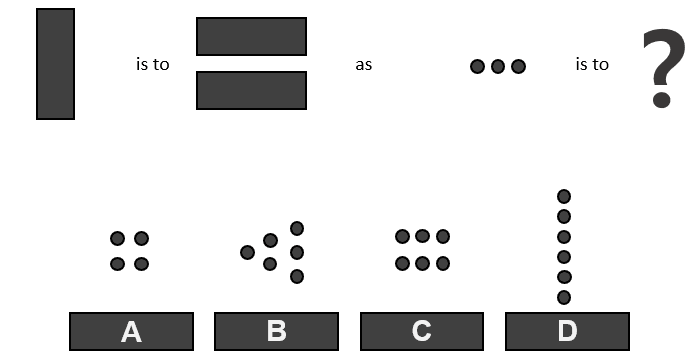
- A
- B
- C
- D
The correct answer is D
Explanation: Element TWO is a product of two steps:
A. rotating Element ONE by 90 degrees clockwise;
B. duplicating the rotated Element ONE and placing both duplicates one on top of the other.
Element ONE is a vertical column, therefore Element TWO is a set of two identical horizontal columns. Element THREE is three little circles aligned horizontally, therefore, Element FOUR should be the same circles doubled and aligned vertically (90 degrees rotation) one on top of the other, forming a sequence of six little circles.
Tips & Tricks:
An intuitively correct answer would be a set of six circles, similar to option C, but in a vertical orientation. Since this intuitive solution is not included in the answers, you should adapt your reasoning to fit one of the provided answers.
Verbal Reasoning
Harver’s Verbal Reasoning test predicts activities involving abstract thinking, analytical problem-solving, and verbal insight. It measures an individual’s ability to discover relationships or connections between several verbal concepts in a format known as verbal analogies or word analogy.
Sample Question
PURIFY is to SULLY as POIGNANT is to…
- dirty
- piquant
- lively
- healthy
- damaged
- unmoving
The correct answer is POIGNANT is to UNMOVING.
Explanation:
The analogy underlying this question is A and B are opposites.
Poignant is something that drives various emotions while unmoving is something that does not. These are also opposites.
The other options are either synonyms, nearly synonyms, or unrelated to the word poignant.
Perceptual Speed and Accuracy
This test predicts success in jobs that involve ordering, sorting, and information verification. It measures a candidate’s efficiency in performing a relatively new task.
Sample Question
Are these two sequences of letters the same or different?
TGKOPY – TGKOPY
- the same
- not the same
Both sequences are the same.
Numerical Reasoning
The Numerical Reasoning assessment tests how well a candidate will perform on jobs that require abstract thinking, analytical problem-solving, and numerical insight. It evaluates the candidate’s ability to find and recognize numerical sequences.
Sample Question
What is the next number in the following series of numbers?
5 6 11 17
- 19
- 23
- 25
- 28
The correct answer is 28.
Explanation:
Look at the differences between the numbers:
5 6 11 17
+1 +5 +6
While there is no simple pattern to the differences, you do get a hint that the second and third differences are equal to the first two numbers of the original series. You can assume that the next difference should be 11 as it is the number that follows 6 in the series.
Thus, the next number of the series is 17 + 11 = 28
The complete logic of the series is that every term in the series equals the sum of the previous two terms.
It can be formally written as follows – an+2 = an + an+1
The next number of the series is equal to 11 + 17 = 28
For learning purposes, the next numbers of the series would be:
17 + 28 = 45
28 + 45 = 73
45 + 73 = 118
And for general knowledge: Did you know that any series of numbers in which each number (third in sequence and above) is the sum of the two preceding numbers is known as the Fibonacci sequence, named after Italian mathematician Leonardo of Pisa, known as Fibonacci?
Spatial Ability
The spatial ability test measures the candidate’s ability to visualize and manipulate shapes. It helps an employer predict the performance of a candidate’s spatial orientation. Spatial ability is also associated with strategic thinking as it displays how the candidate visualizes the bigger picture.
Sample Question
Which of the four options represents the following shapes combined?
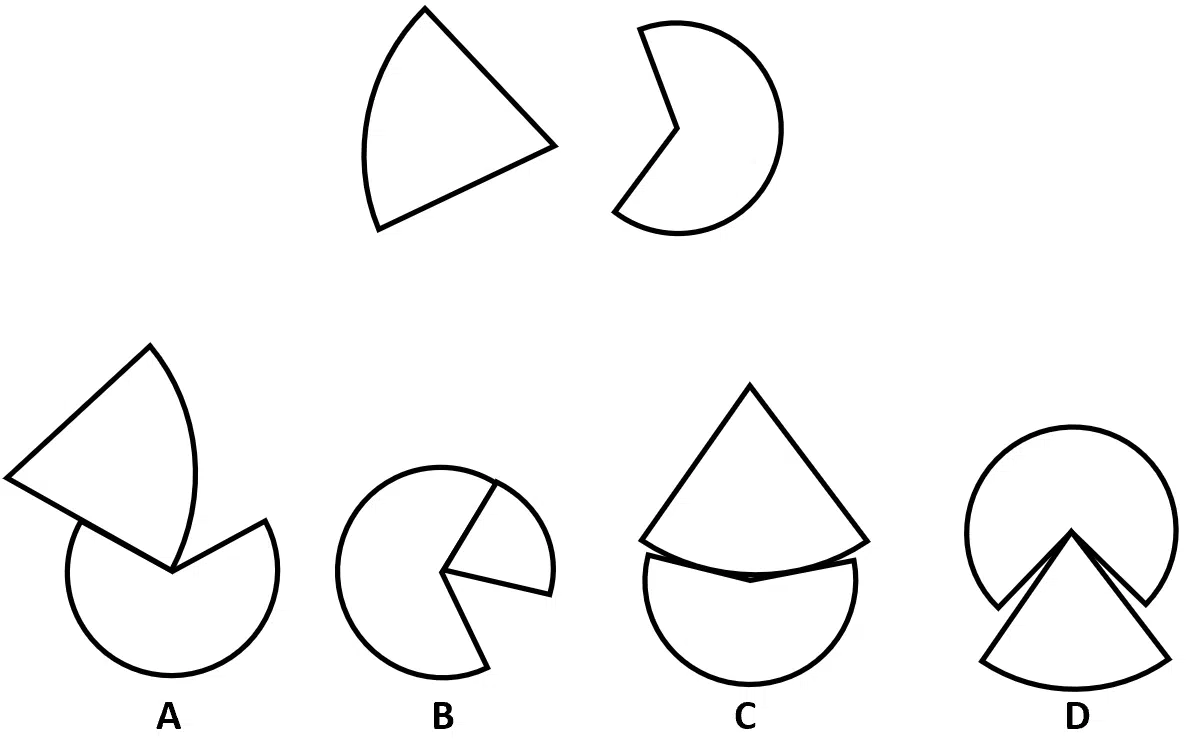
The correct answer is image A. It comprises the original shapes rotated.
In image B, the smaller portion was resized.
In images C and D, the angle of the bigger image was altered.
The Importance of Cognitive Ability Tests
Cognitive ability tests are considered to be reliable measures of cognitive abilities. Also known as aptitude tests, they assess an individual’s general mental ability or intelligence including reasoning, problem-solving, and decision-making abilities.
Cognitive ability tests are often used in hiring because they predict job performance across several industries and job types. The tests are based on established psychometric principles and are designed to be objective and unbiased measures of cognitive ability.
However, it is essential to note that cognitive ability tests should not be used in isolation when making hiring decisions. Factors such as work experience, education, and personality traits should also be considered.
Cognitive ability tests are generally reliable measures of cognitive abilities. Still, they should be used in conjunction with other assessment tools and interpreted in the context of the specific job requirements and the candidate’s overall profile.
Personality Questionnaire
Harver’s Personality Questionnaire is an essential component of the Harver pre-employment assessment platform. It evaluates a candidate’s personality traits and characteristics relevant to job performance. It helps employers gain a deeper understanding of a candidate’s work style, preferences, and potential cultural fit within the organization.
The Personality Questionnaire is based on the HEXACO personality assessment, which is built on the well-established and widely accepted “Big Five” or “Five-Factor Model.” It comprises six broad dimensions of personality traits. These dimensions include
Honesty / Humility: This dimension measures an individual’s sincerity, fairness, greed avoidance, and modesty. High scores on this dimension indicate that a person is sincere, fair, and straightforward in their interactions with others, and less likely to be motivated by personal gain or status-seeking behaviors. Low scores, on the other hand, may suggest that a person is more inclined towards selfish, manipulative, and status-seeking behaviors, and may be less honest and more likely to engage in deceptive or exploitative behaviors.
Openness to Experience: This dimension measures a candidate’s creativity, curiosity, and willingness to embrace new ideas and experiences. High levels of openness are generally associated with adaptability, innovation, and intellectual curiosity. Lower levels suggest a preference for routine and familiarity.
Conscientiousness: Conscientiousness evaluates a candidate’s level of organization, reliability, and self-discipline. Highly conscientious individuals are typically detail-oriented, responsible, and dependable. Those with lower conscientiousness may be more spontaneous and flexible in their approach to work.
Extraversion: Extraversion assesses a candidate’s sociability, assertiveness, and outgoingness. Highly extroverted individuals are often energetic, talkative, and comfortable in social situations, while introverted individuals may be more reserved and prefer solitary activities or small group interactions.
Agreeableness: This dimension measures a candidate’s cooperativeness, empathy, and warmth toward others. Highly agreeable individuals are typically compassionate, helpful, and team-oriented. Those with lower agreeableness may be more competitive, independent, and critical in their interactions.
Emotional Stability: Also referred to as neuroticism, emotional stability evaluates a candidate’s ability to cope with stress, maintain emotional composure, and adapt to changing circumstances. Individuals with high emotional stability are generally calm, resilient, and optimistic, while those with lower emotional stability may be more prone to anxiety, mood swings, and negative emotions.
The Harver Personality Questionnaire presents candidates with a series of statements or scenarios, asking them to rate their level of agreement or choose the option that best describes their behavior or preferences. By analyzing the responses, the questionnaire generates a comprehensive profile of the candidate’s personality traits which employers can use to assess their suitability for specific job roles and organizational culture.
Sample Question
People have hidden motives when they offer help –
- Strongly Agree
- Agree
- Neutral
- Disagree
- Strongly Disagree
This statement tries to assess how cynical you are, whether you are prone to doubt others’ intentions and assume they have bad ulterior motives. Generally, it may reflect various aspects of trust or mistrust.
People who tend to agree with similar statements are prone to negativity and are quarrelsome. People who tend to strongly disagree may not examine others’ true intentions carefully enough. Moderate or neutral responses indicate a balanced approach between trusting people and doubting them.
Situational Judgement Test (SJT)
Harver’s Situational Judgment Test (SJT) is a critical component of Harver’s pre-employment assessment platform. It evaluates a candidate’s decision-making and problem-solving abilities in work-related scenarios. The SJT helps employers assess their capacity to handle challenging situations, prioritize tasks, and work effectively within their position and the organization’s culture.
The Situational Judgment Test presents candidates with hypothetical, job-specific scenarios they might encounter in their prospective role. Several possible actions or responses accompany each scenario, and the candidate must either rank these actions based on their effectiveness or choose the most appropriate and least appropriate response. The test aims to gauge candidates’ ability to make sound judgments and decisions in various work situations, drawing upon their critical thinking, interpersonal skills, and understanding of professional norms and expectations.
Sample Question
A clerk in your unit performs work quickly but carelessly. This clerk is about to transfer to another unit. The head of that unit asks you for your opinion of the employee’s work.
What would be the BEST course of action to handle this situation?
- Emphasize the employee’s good points and downplay the bad.
- Allow the employee to begin with a clean record by avoiding any criticism.
- State that the employee works quickly but carelessly.
- Warn the unit head that he or she would be making a big mistake by hiring the employee.
The best answer is C.
Stating the truth, is the best answer to this question. People have trouble with some supervisory questions is because they may answer a question based on experiences they have seen or participated in. On your upcoming test, that is not always a good idea, as you might miss a question like this for that reason.
Option A is a very common answer, and incorrect. Of course, people do this all the time in real life to be nice, or because they want to unload someone. However, it is not considered good supervisory practice. While it may help your unit, it won’t help the other unit, the organization, or the individual involved. Option B is incorrect for the same reason. Option D is incorrect because it is going to the other extreme, and that would also not be fair to the employee.
Primary Objectives of Situational Judgement Test
Assessing Decision-Making Skills: The test evaluates a candidate’s ability to analyze situations, weigh the pros and cons of different actions, and make effective decisions under varying circumstances.
Evaluating Problem-Solving Abilities: The SJT measures a candidate’s capacity to identify problems, consider potential solutions, and select the best course of action.
Identifying Behavioral Tendencies: The test reveals a candidate’s behavioral tendencies in various work situations, such as their inclination towards collaboration, conflict resolution, leadership, or compliance with company policies and procedures.
Assessing Job Fit: By presenting job-specific scenarios, the SJT helps employers determine whether candidates possess the necessary skills, knowledge, and judgment to succeed in a particular role.
Predicting On-the-Job Performance: Research has shown that situational judgment tests are reliable predictors of job performance. They evaluate a candidate’s ability to handle real-life work challenges and make decisions under pressure.
Harver’s Situational Judgment Test is a valuable tool for employers seeking to identify candidates who can effectively navigate the challenges and complexities of their job role. It assesses a candidate’s decision-making, problem-solving, and behavioral tendencies. It provides employers with a comprehensive understanding of a candidate’s potential job performance and fit within the organization. It enables more informed hiring decisions, resulting in better job matches, increased employee satisfaction, and improved retention rates.
Learning Agility Test
The test is based on learning agility, which refers to an individual’s ability to quickly learn from experience and apply that learning to new situations. This ability is critical in the present fast-paced and constantly evolving work environment.
Harver’s Learning Agility Test is a combination of cognitive and behavioral assessments that measure the following five dimensions of learning agility:
Mental Agility: This dimension measures a candidate’s ability to analyze complex information, think critically, and make sound decisions.
People Agility: This dimension measures a candidate’s ability to work effectively with others, build relationships, and influence others.
Change Agility: This dimension measures a candidate’s ability to adapt to change, be open to new ideas, and take calculated risks.
Results Agility: This dimension measures a candidate’s ability to deliver results in a fast-paced and changing environment.
Self-Awareness: This dimension measures a candidate’s ability to reflect on their strengths and weaknesses, seek feedback, and continuously learn and develop.
Other Harver Assessments
The Harver platform conducts additional assessments which are listed in the following table.
| Name of the Test | Format | What test measures |
|---|---|---|
| Typing Test | Consists of several passages of increasing complexity. The user must type each passage as accurately and quickly as possible. | Typing speed in words per minute (WPM), accuracy percentage, and other statistics such as the number of keystrokes, and errors made. |
| Spoken Language Test | The test assesses different aspects of language, including grammar, vocabulary, comprehension, and production. | Evaluates a person’s ability to communicate effectively in spoken English. |
| Work From Home Simulation | This simulation consists of diagnostic tools that assess internet connectivity, hardware compatibility, ergonomic setup, and environmental conditions like lighting and noise. | Provides personalized recommendations for improving the user’s WFH environment, which may include upgrading hardware or software, improving internet connectivity, etc. |
| Live Chat Support Simulation | This simulation presents the candidate with chat-based scenarios that simulate real-life customer support interactions. | Assesses communication and problem-solving skills in a virtual chat environment. |
| Open Questions | Harver’s open questions are interview questions that allow job candidates to give detailed and personalized responses, providing employers with deeper insights into their experience, skills, and attitudes | Assesses a candidate’s communication skills, critical thinking abilities, and ability to articulate their thoughts clearly and concisely. |
| Language Proficiency | This tool uses a combination of grammar, vocabulary, reading, writing, and speaking tests to determine the individual’s level of proficiency in the language. | The tool uses a combination of grammar, vocabulary, reading, writing, and speaking tests to determine the individual’s level of proficiency in the language. |
| Cultural Fit Assessment | The assessment consists of questions that assess the individual’s personal values, work preferences, and attitudes toward teamwork, leadership, and other aspects of the company’s culture. | Evaluates how well an individual’s values, personality, and work style align with the company’s culture and values. |
| Multitasking Test | The test consists of a series of simulated scenarios, each of which requires the individual to perform multiple tasks simultaneously. | The test evaluates a person’s cognitive abilities, including attention to detail, working memory, and task switching. |
Preparation Strategies
Practice Under Exam Conditions
Make every practice count by imposing examination conditions and time limits. While some individuals prefer to assign a specific time limit for every question, others try to answer as quickly as possible and take another look at the questions they found challenging in their initial attempt. Whatever strategy you adopt, ensure you approach every mock test as if you are sitting in the examination hall at that moment.
Make Mistakes, and Learn From Them
Practice will help you get familiar with the assessments, but unlike the real tests, you are allowed to make mistakes and learn from them.
Certain sections of the assessments will be more challenging than others. However, this differs from person to person. Focus on your weaknesses so you can improve accordingly.
Create a Study Plan
There are many strategies you can implement to get a better score on a Harver assessment. These include brushing up on your math skills, reading more widely for the verbal questions, or engaging in ‘brain training’ games for logical thinking problems.
Review the Job Description
Before taking the assessments, review the job description to understand the skills and traits required for the role. Doing so will help you anticipate the questions and tasks you may encounter during the assessments. It will be particularly helpful in developing an approach for the personality test.
Practice Sample Tests
Find sample tests or practice materials online that closely resemble the Harver Assessments you’ll be taking. Practice will help you get familiar with the test format, question types, and time constraints, improving your overall performance. If you choose a preparation course that includes Harver practice tests, you’re already off to a good start.
Improve Your Cognitive Abilities
Some Harver Assessments, such as cognitive ability tests, may require you to solve problems related to numerical, verbal, or abstract reasoning. Practice solving puzzles, brainteasers, and other reasoning exercises to enhance your cognitive abilities
Harver Assessments Test Tips
Harver Assessments are pre-employment tests designed to evaluate a candidate’s job-related skills, cognitive abilities, and personality traits. These assessments help organizations identify the best-fit candidates for specific job roles. To perform well on Harver Assessments, follow these tips and strategies:
1. Understand the Assessment Format and Content
Harver Assessments may include various tests, such as cognitive ability tests, situational judgment tests, personality assessments, and job-specific skill tests. Familiarize yourself with the specific tests you’ll be taking and their formats.
2. Answer All the Questions
Some assessments might implement negative marking for a wrong answer, while others don’t have any penalty for an incorrect answer. If the assessment you are taking does not mark you down for a wrong answer, then it’s advisable to make your best guess on a question that you are not sure of. Most of the questions are multiple-choice, so you at least have a chance of getting the question right.
3. Check Your Technology and Extras
As these assessments are generally taken through an online portal, your device must be updated with the latest technology.
You must have a reliable internet connection. Some assessments may be taken on a tablet or smartphone, but it is better to use a computer or laptop.
4. Avoid Distractions
Creating exam conditions means finding a quiet space and turning off electronic devices.
The assessments are short – often just 30 minutes – so you don’t have any time for distractions.
5. Manage Your Time Effectively
Harver Assessments may be timed, so ensure you manage your time effectively during the test. Avoid spending too much time on any question and maintain a steady pace throughout the assessment.
6. Stay Calm and Focused
Test anxiety can negatively impact performance. Stay calm by practicing relaxation techniques such as deep breathing or visualization, and maintain focus throughout the assessment.
7. Prepare on Test Day
Taking any assessment is a nerve-wracking experience, and when we are talking about landing a dream job, there is extra pressure involved. Put yourself in the best shape to get through it by ensuring you are well-rested the night before and by eating a healthy meal before you begin. And the most important part, remain hydrated.
These strategies and tips will increase your chances of performing well on Harver Assessments and allow you to showcase your skills and suitability for the job role.
Test Features
Customizable Assessments
Harver assessments can be customized to meet the organization’s hiring needs as follows:
Job-specific assessment: The tests could be customized based on the specific skills and competencies required for a particular role.
Branding: Assessments can be customized to match the branding of the organization, such as logos, fonts, and colors, providing a consistent candidate experience.
Assessment modules: The organization can only include assessments that measure traits required for the position.
Scoring and weighting: Organizations may customize the scoring and weighting of the assessment to reflect the relative importance of different skills for a particular job.
AI-Driven Assessments
All Harver assessments are AI-driven. The platform uses data-driven insights to provide organizations with an accurate and objective way to assess candidates, reducing the risk of human bias. Harver’s AI algorithms analyze behavioral and historical hiring data to identify patterns and predict the likelihood of a candidate’s success in a particular role.
Harver’s AI technology also enables the platform to offer a personalized candidate experience, which helps organizations attract and retain top talent. The platform uses data to create a customized assessment for each candidate.
Candidate Friendly Interface
Harver assessments are interactive and engaging. They use gamification elements such as animations, progress bars, and feedback messages to ensure candidates are motivated and focused throughout the process.
Additionally, Harver provides candidates with clear instructions and guidance on each assessment, reducing the risk of confusion or misunderstandings. The platform also offers candidates the opportunity to practice and familiarize themselves with the assessment format.
Technical Facts
Harver Assessments Fast Facts
Assessments offered: Cognitive ability, Personality Questionnaire, Situational Judgement Tests (SJTs), etc.
Multiple Choice Questions for most items
Passing or failing criteria set by the hiring company
All assessments are computer-based
Assessments are customizable
Question Types: Question type varies according to the assessment you are taking. However, some common question types include; MCQ, True or False, Numerical Reasoning, Verbal Reasoning, Abstract reasoning, Situational judgment, Personality, and Language proficiency questions.
Assessments to Fit Every Need
The six assessment categories offered by Harver help organizations find the right talent regardless of the industry, stage, or job role. These categories include
Traditional Behavioural: Boost the quality of the hire by analyzing candidates’ traits and deposition while mitigating bias.
Gamified Behavioural: Improve matching while developing or hiring talent with engaging assessments in a gamified format.
Cognitive: Predict success across roles and industries by analyzing problem-solving, reasoning, and various types of intelligence.
Job Knowledge & Skills: Helps to analyze whether a candidate is fit for a role by analyzing their generic or industry-specific hard skills.
Realistic Job Previews: Increases candidate satisfaction and quality by measuring responses to common challenges.
Work From Home: Helps companies hire employees for remote roles by analyzing their computer specifications and internet speed.
Harver assessments are highly customizable and can be altered to fit a wide range of needs making them versatile tools for companies of all sizes and industries. Additionally, employers can choose from the assessments offered to help them test the right skills required for an open role.
Mitigate Bias to Build Better Teams
Harver assessments help mitigate bias in the hiring process and build better, more diverse teams in the following ways:
Standardized assessments: The assessments are standardized, meaning every candidate is presented with the same format and questions.
Objective assessment criteria: Harver assessments use objective criteria based on job requirements and competencies rather than subjective factors such as personal preferences or biases.
Blind screening: Harver assessments can be combined with blind screening where identifying information such as name, gender, and ethnicity is removed from the candidate’s application.
Machine learning algorithms: Harver assessment uses machine learning algorithms to analyze candidates’ data and provide insight into their skills, abilities, and personality traits.
Harver assessments mitigate bias in the hiring process. Their tests help build more diverse and inclusive teams that are better equipped to meet the challenges of today’s business environment.
Integration
The Harver platform can be integrated with other HR and recruitment software, such as applicant tracking systems (ATS), to streamline the hiring process and improve efficiency.
Language and Geography
Harver assessments are available in multiple languages, making them accessible to candidates worldwide.
Results Scale and Interpretations
Harver assessment results provide employers with valuable insights into a candidate’s suitability for a particular role. The platform analyzes results based on various factors, including cognitive abilities, personality traits, and job-specific competencies. The following sections will detail key aspects of this process:
Cognitive Abilities: Harver assessments may evaluate a candidate’s cognitive abilities, such as numerical reasoning, verbal reasoning, and abstract reasoning. These tests measure an individual’s capacity to process information, solve problems, and think critically. The platform analyzes the candidate’s performance on these tests to determine their overall cognitive ability score.
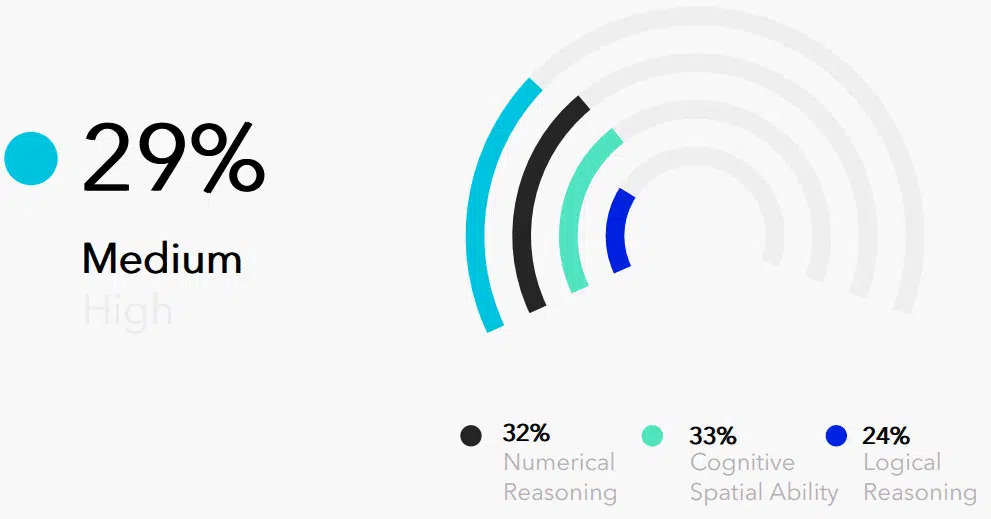
Personality Traits: Harver assessments can also assess a candidate’s personality traits using several psychometric tools. These evaluations measure extraversion, agreeableness, conscientiousness, emotional stability, and openness to experience. The platform uses this data to create a comprehensive personality profile that can help employers understand how a candidate may fit within their team and corporate culture.
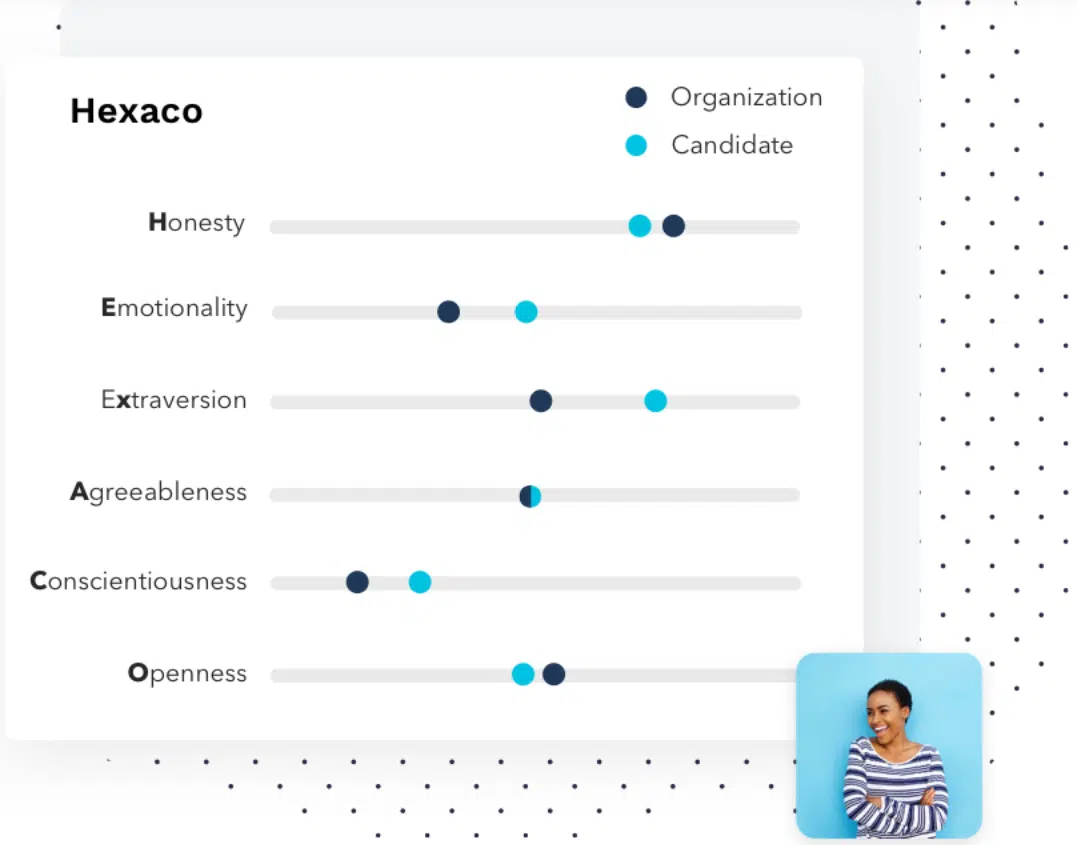
Job-Specific Competencies: In addition to cognitive and personality assessments, Harver can also measure job-specific competencies. These assessments evaluate skills and knowledge relevant to a particular role, such as technical skills, communication abilities, or leadership qualities. The platform evaluates the candidate’s performance on these assessments to provide a detailed understanding of their potential fit for the role.
Benchmarking and Comparison: Harver compares candidates’ assessment results to benchmarks, which are often established by analyzing the performance of successful employees within a particular role or industry. By comparing the candidate’s scores to these benchmarks, the platform can offer employers a better understanding of a candidate’s potential to succeed in the given role.
Customized Reports and Data Visualization: Harver provides employers with customized reports that summarize the candidate’s performance on various assessments. These reports may include data visualizations, such as graphs and charts, that help employers quickly and easily understand the candidate’s results. The platform can also provide detailed information on specific areas of strength and potential development areas for each candidate.
Integration with Applicant Tracking Systems (ATS): Harver’s platform can be integrated with various Applicant Tracking Systems (ATS) to streamline the recruitment process for employers. This integration enables employers to easily access assessment results, compare candidates, and make informed hiring decisions based on data-driven insights.
Harver assessment result analysis offers a comprehensive understanding of a candidate’s cognitive abilities, personality traits, and job-specific competencies. By comparing results to benchmarks and providing customized reports, the platform helps employers make informed, data-driven hiring decisions that can lead to better employee performance and increased organizational success.
Harver Assessment Scores Explained
Although all Harver assessment reports are customized as per the role and the organization, they all follow a common scoring format which includes the following sections:
- Matching score
- Benchmarking
- Interpretation of Norm-referenced scores
Here is what each section entails:
Matching score: The total matching score indicates how close a candidate matches the open role requirements based on their performance on various testing modules of the assessment.
Every module has its matching score, which is calculated by either:
- The candidate’s norm-referred score or absolute raw score on the test module. The better a candidate performs, the higher the matching score they get.
- Comparing the benchmark value with the candidate module score. The closer the candidate’s score to the benchmark value, the better their matching score.
If the assessment flow includes multiple modules, the matching percentage is averaged with the other module’s matching percentage resulting in a total matching percentage.
Benchmarking: Some testing modules require a set of benchmarks. The benchmark represents the ideal candidate’s ideal score. The company sets these benchmark values which estimate the actual performance of existing employees, or industry standards.
Interpretation of Norm-referenced scores: A few of the assessment module scores are referred to as norm, which means that an individual candidate’s score is compared to the score of other candidates taking part in the exam: the norming group. The standardized norm score is calculated based on this comparison.
For Example, If a candidate achieves a matching score of 50, he is average compared to the norming group. 50% of the group members scored lower, and 50% scored higher than him.
If a candidate scores 90%, they are part of the top 10% of the norming group.
Matching Your Results to the Benchmark Profile
Harver’s matching process helps employers make data-driven hiring decisions by providing them with accurate, objective, and relevant information about each candidate’s fit for the role.
The Basics of Matching Profiles
Harver’s assessment results are matched to benchmark profiles through a job analysis process. Job analysis identifies the competencies, skills, and traits required for a particular job. This information is then used to create a benchmark profile that outlines the ideal candidate for that role.
To create a benchmark profile, Harver works closely with employers to understand the specific requirements of the job in question. The process may involve reviewing job descriptions, conducting interviews with current employees, and analyzing performance data.
Once the benchmark profile has been created, Harver’s assessment tests are calibrated to match the specific competencies, skills, and traits identified in the profile. This ensures that the assessment results are tailored to the requirements of the job and that candidates are evaluated against the same standards as other applicants.
Matching Profile Labels
Labels are utilized to group or rank candidates based on their assessment scores concerning the benchmarked results that predict success in a role. Label settings determine how the candidates’ scores will appear in the candidate’s pdf report, detail page, insights, and fact sheet.
Initially, ‘No labels’ are attached to the candidate’s matching indicators and profiles. If not specified by the employers, the candidate’s score would only display as a numeric value.
But in other instances, labels are customized based on the organization’s internal language and workflow.
Companies may choose to enable the cutoff feature. When this feature is active, candidates that score below the benchmark set will be rejected automatically, allowing the employer to focus only on those candidates who are a better fit for the job.
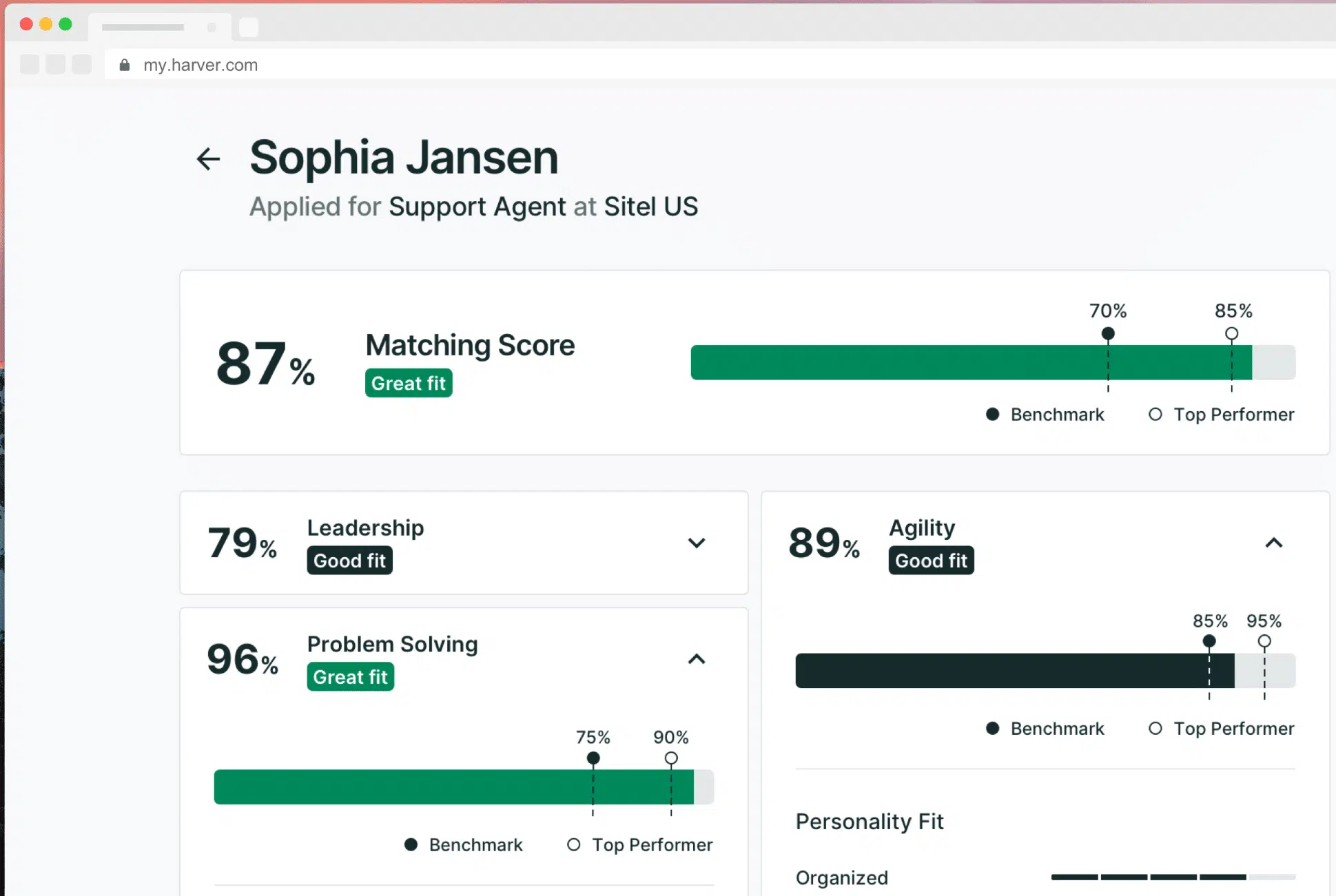
Can I See My Results?
Whether or not a candidate can access their results depends on the company. If the organization has enabled this feature, you can see your result simply by clicking on the button ‘My Result.’
Although the results are available immediately after you complete your test, you may also access them later. Log in with your registered email and password using the link received in the registration email. Once logged in, you will automatically be redirected to the result page.
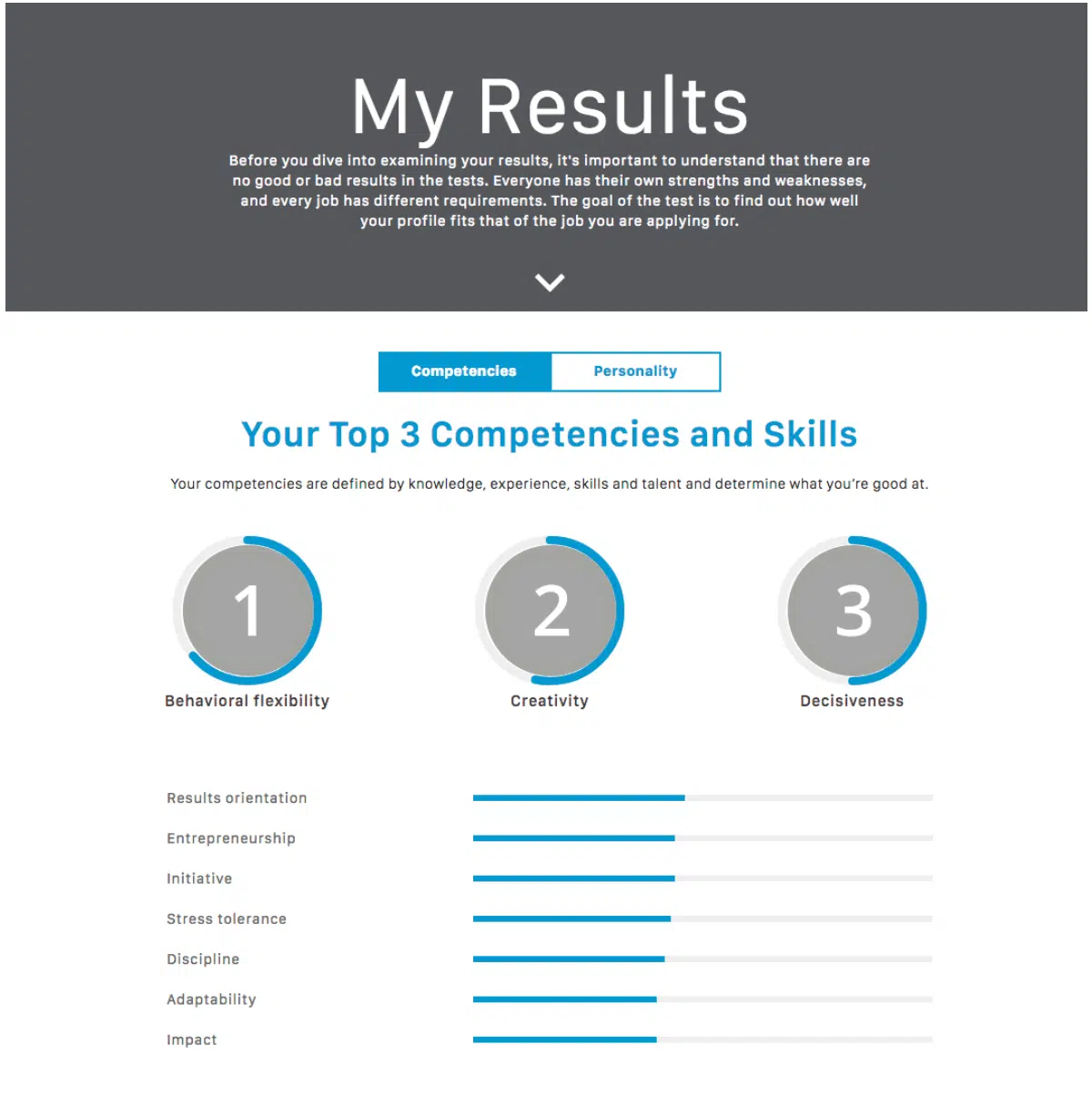
iPREP: Concise. Focused. What you need.
Sign up
Immediate access
Practice
Online self-paced
Pass
Ace that Test!
FAQs
The Harver Assessment is a pre-employment testing platform that uses AI and data science to evaluate candidates for job fit and potential. It assesses cognitive ability, personality traits, and job-related skills to provide data-driven insights for hiring decisions.
The passing score depends upon the assessment you are taking as. For example, 50% is considered average while anything above 70% is regarded as a good score on Harver’s cognitive ability test.
The Harver Assessment typically consists of multiple parts that evaluate different aspects of a candidate’s fit for a specific role. The exact parts vary depending on the job requirements and the organization’s needs, but they may include the following:
* Cognitive Ability Tests – These assessments measure a candidate’s logical, verbal, and numerical reasoning skills.
* Personality Assessments – Evaluations of a candidate’s behavioral traits and characteristics to predict their fit for the role and the organization’s culture.
* Situational Judgment Tests (SJTs) – Scenarios or situations presented to the candidate to assess their decision-making and problem-solving skills.
* Job-Specific Tests – Tests designed to assess a candidate’s knowledge, skills, and abilities related to the job they are applying for.
The Harver Assessment uses AI and data analytics to provide data-driven insights into a candidate’s fit for a particular role. The information helps companies build a comprehensive profile of the candidate’s strengths and weaknesses.
The difficulty level of the Harver Assessments varies depending on the specific job and the assessments for that particular role. Generally, cognitive ability tests and job-specific tests are challenging as they evaluate a candidate’s skills and knowledge in specific areas.
Overall, the difficulty level of the Harver Assessments will depend on the individual candidate’s skills and experience, as well as the specific job requirements.
The Harver Report is a feature of the Harver Assessment platform that provides hiring managers and recruiters with data-driven insights into a candidate’s fit for a specific role. The report includes a detailed analysis of the candidate’s performance on various assessments, including cognitive ability tests, personality assessments, and job-specific tests.
The Harver Report also includes a comparison of the candidate’s scores to a benchmark or reference group which helps identify how well the candidate performs relative to others in the same job or industry. This information can be used to make informed hiring decisions and to identify candidates who are the best fit for the organization’s needs.
The length of a Harver Assessment varies depending on the specific job requirements and the assessments being used for that particular role. It can take anywhere from 30 minutes to several hours to complete depending on the complexity of the job and the number of assessments being used.
Administration
Test Administrators: Harver conducts all the assessments through its platform.
Test Schedule: Harver assessments are typically scheduled by the hiring company or organization as a part of their hiring or recruitment process.
Test Format: Mostly multiple choice computer-based tests.
Test Materials: A computer-based exam; no extraneous material is allowed at the test centers.
Cost: Generally covered by the employer.
Retake Policy: Typically, retake policies for pre-employment assessments vary according to company, role, and the specific assessment. Some organizations may allow candidates to retake assessments after a certain period, while others might have a stricter, one-attempt-only policy.
Test Provider
Every Harver assessment, including cognitive ability, personality questionnaire, and situational judgment tests, is provided by the Harver company. These assessments are developed and provided by Harver BV, which is headquartered in Amsterdam, Netherlands. The tests are delivered through an easy-to-use online platform that streamlines the recruitment process for employers and creates a more engaging and efficient experience for candidates.
Information Sources
Disclaimer – All the information and prep materials on iPrep are genuine and were created for tutoring purposes. iPrep is not affiliated with Harver, the owners, and providers of Harver assessments.
Free Harver practice test: Get to know what the Harver Assessment Tests will be like by practicing with these sample questions:
Question 1 of 16 – Verbal Reasoning
HOUSE is to CELLAR as SHIP is to…
- river
- water
- hold
- siege
- waves
The correct answer is “hold”.
Explanation: The analogy underlying this question is that B is a lower storage area in A.
A cellar is a lower storage area in a house, and a hold is a lower storage area on a ship.
One may claim that a cellar is found beneath a house, the same as water or waves are found beneath ships. However, there are two reasons why none of these is the correct answer:
- The correct answer presents a more concrete analogy
- As there is more than a single plausible answer for “something beneath a ship”, a better analogy must be drafted.
Question 2 of 16 – Verbal Reasoning
MEMBRANE is to CELL as ATMOSPHERE is to…
- ground
- earth
- sky
- meteor
- space
- gas
The correct answer is “earth”.
Explanation: The analogy underlying this question is that A surrounds B.
A membrane surrounds the cell. The atmosphere surrounds the Earth.
Question 3 of 16 – Verbal Reasoning
STUDY is to TEST as PACK is to…
- package
- potatoes
- suitcase
- unpack
- vacation
- exam
The correct answer is “vacation”.
Explanation: The analogy underlying this question is that A is done for B.
One studies for a test; one packs for a vacation.
The word pack is can be related to many of the other options but unless you manage to create an identical analogy between the example and the question, these merely serve as distractions.
Question 4 of 16 – Logical Reasoning
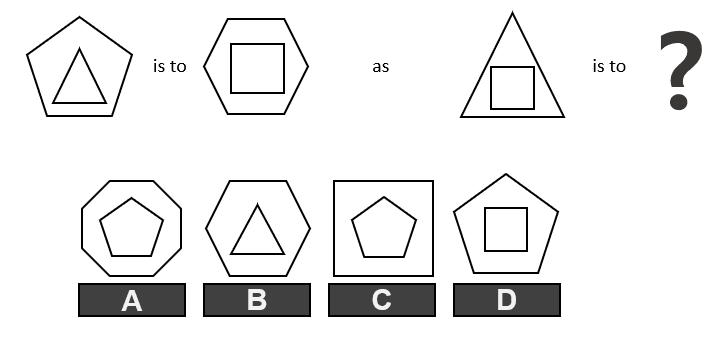
- A
- B
- C
- D
The correct answer is C.
Explanation:
Each of the elements is comprised of two shapes, one within the other. Elements ONE and TWO create the following analogy:
The number of edges of each of the shapes of element TWO is greater by one in comparison to the respective shape of element ONE. Outer pentagon → outer hexagon; inner triangle → inner quadrangle.
Element THREE is a square within a triangle. In order to maintain the analogy, each of the shapes of element FOUR must include one additional edge. Outer triangle → outer quadrangle; inner square → inner pentagon. Answer C is the only one that complies.
Tips & Tricks:
- Mutually exclusive characteristics – in a case where you find two options that fit a possible explanation of the analogy, they mutually exclude themselves as the correct answer. In most cases, it means that the explanation of the analogy was not complete and that it needs to be refined.
In this case, one possible explanation of the analogy between elements ONE and TWO is that the overall number of edges of the shapes of element TWO is greater by two in comparison to the overall number of edges of the shapes of element ONE (ten edges vs. eight edges). If so, since there are a total of seven edges in element THREE, you would expect nine edges in element FOUR. However, answers B, C, and D all comply with this logic. The conclusion is that the logic is either incorrect or that it needs to be refined.
Question 5 of 16 – Logical Reasoning
Which of the following boxes should replace the question mark (?) to complete the pattern?
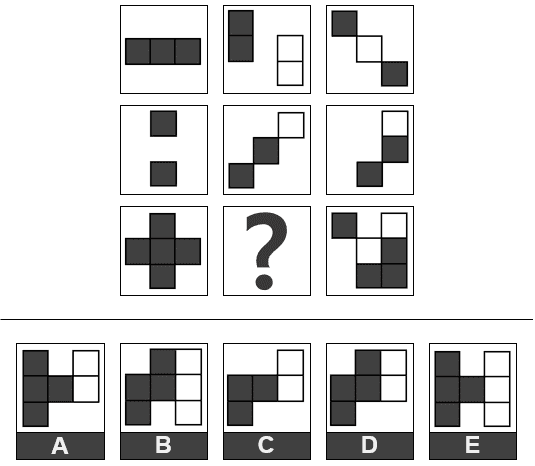
- A
- B
- C
- D
- E
The correct answer is E
Explanation: the solution in this case goes only according to the logic by column. The element in each of the cells of the bottom row is the combination of the elements of the top and middle rows, of the same column. Option E is exactly that.
Question 6 of 16 – Logical Reasoning
Which of the following boxes should replace the question mark (?) to complete the pattern?
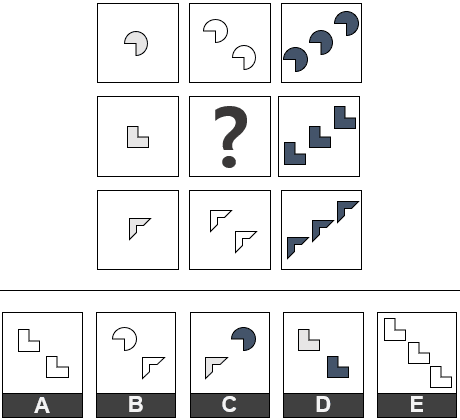
- A
- B
- C
- D
- E
The correct answer is A.
Explanation:
The elements of each row consist of the same type of shape.
The elements of each column consist of the same number of shapes, which are all in the same color.
In addition, from left to right, the number of shapes in each element increases by one.
According to the above, the missing element should consist of the same type of shape as the elements of the middle row and the same number and color of shapes as the middle column—two white L-shapes.
Tips & Tricks:
- Remember the principle of simplicity—if the entire question contains simple features, then the solution is probably simple as well. For example, all the elements of the matrix consist of shapes of the same color. According to the principle of simplicity, the chance that the correct answer contains a combination of colors is very slim. Considering that, you can disregard choices C and D.
Question 7 of 16 – Logical Reasoning
Which of the following boxes should replace the question mark (?) to complete the pattern?
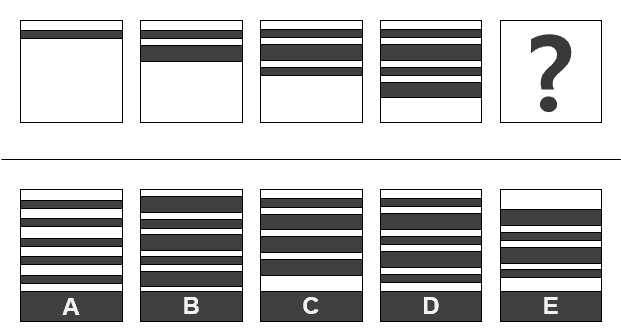
- A
- B
- C
- D
- E
The correct answer is D
Explanation: Each element contains a growing number of horizontal stripes. The additional stripe is alternately narrow or wide; therefore, the additional line in the last element must be narrow. The rest of the stripes in each element maintain their position.
Tips:
Remember, you do not have to completely describe the logic of the sequence. It is usually enough to fully grasp one or two elements in order to choose the correct answer.
Question 8 of 16 – Logical Reasoning
Which of the following boxes should replace the question mark (?) to complete the pattern?
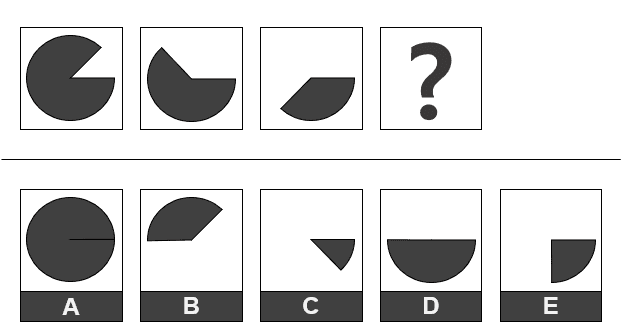
- A
- B
- C
- D
- E
The correct answer is C
Explanation: From left to right, going counterclockwise, in every element, a 90-degree portion is removed. Therefore, the last element will only contain a small 45-degree portion, as appears in answer C.
Question 9 of 16 – Logical Reasoning
Which of the following does not belong?

- A
- B
- C
- D
- E
The correct answer is E
Explanation: The base of each of the shapes within the elements is at the bottom except shape E, whose base as at the top.
Tips:
In order for an element to be the odd one out, it needs to be truly unique. In this example, only element C contains a triangle. One may claim that this makes it the odd one out. However, elements B and D contain quadrangles, and elements A and E contain pentagons. This means that for the property “number of edges,” elements A, B, D, and E do not share the same characteristic. This means that element C is not the odd one out.
Question 10 of 16 – Logical Reasoning
Which of the following does not belong?

- A
- B
- C
- D
- E
The correct answer is E
Explanation: Each element but element E contains three shapes – a circle, a square, and a triangle – contained within one another. Element E includes only a circle and a triangle and does not contain a square.
Question 11 of 16 – Perceptual Ability
Are these two sequences of letters the same or different?
NVORKG – NVOPKG
- the same
- not the same
The sequences are not the same.
The fourth letter is different.
NVORKG – NVOPKG
Question 12 of 16 – Perceptual Ability
Are these two sequences of letters the same or different?
FRNIHS- FRNIHS
- the same
- not the same
Both sequences are the same.
Question 13 of 16 – Perceptual Ability
Are these two sequences of letters the same or different?
OEKFND – OKEFND
- the same
- not the same
The sequences are not the same.
The second and third letters are transposed.
OEKFND – OKEFND
Question 14 of 16 – Numerical Reasoning
What is the next number in the following series of numbers?
41 29 17 5
- 3
- 0
- 1
- -7
The correct answer is -7.
Explanation:
Look at the differences between the numbers:
41 29 17 5
-12 -12 -12
This means that every number in the series is equal to the previous number -12.
It can be formally written as follows: an+1 = an – 12
The next number of the series is equal to 5 – 12 = (-7)
For learning purposes, the next numbers of the series would be:
-7 – 12 = -19
-19 – 12 = -31
-31 – 12 = -43
Question 15 of 16 – Numerical Reasoning
What is the next number in the following series of numbers?
3 5 9 17 33
- 45
- 57
- 65
- 71
The correct answer is 65.
Explanation:
Look at the differences between the numbers:
3 5 9 17 33
+2 +4 +8 +16
*2 *2 *2
The differences between each term are multiplied by 2 in every step. Therefore, the difference between the last displayed number of the series and the next number should be 16*2 = 32.
The next number of the series is, therefore, 33 + 32 = 65.
Another way to look at the differences is to realize that there is a consistent relationship between the series of difference and the original series. Each difference equals the number of the series minus one (“1”), or simply each number in the series of differences is the previous natural number in comparison to the original series.
It can be formally written as follows: an+1 = an + (an – 1)
For learning purposes, the next numbers of the series would be:
65 + 64 = 129
129 + 128 = 267
Question 16 of 16 – Numerical Reasoning
What is the next number in the following series of numbers?
1 -2 4 -8
- 18
- -16
- -12
- 16
The correct answer is 16.
Explanation:
Look at the differences between the numbers:
1 -2 4 -8
*(-2) *(-2) *(-2)
This means that every number in the series is equal to the previous number times -2.
It can be formally written as follows: an+1 = an * (-2)
The next number of the series is equal to (-8)*(-2) = 16
For learning purposes, the next numbers of the series would be:
16*(-2) = (-32)
(-32)*(-2) = 64
Well done!
You have completed the Sample Questions section.
The complete iPREP course includes full test simulations with detailed explanations and study guides.
‘…TESTS THAT ACTUALLY HELP’

In the first 30 minutes of use I have learned so much more than skipping along the internet looking for free content. Don’t waste you time, pay and get tests that actually help.
Richard Rodgers
January 28, 2020 at 7:49 PM